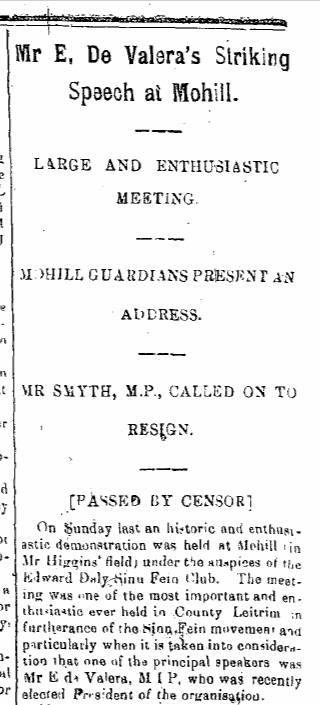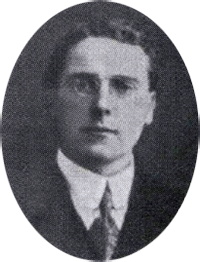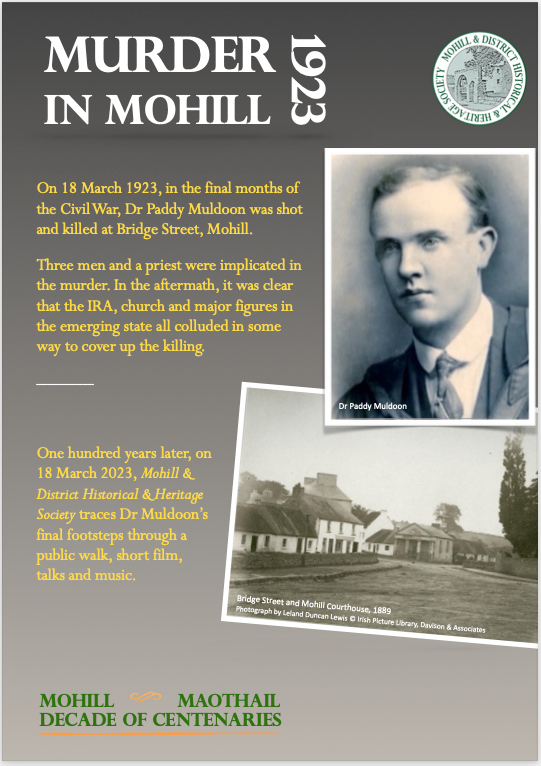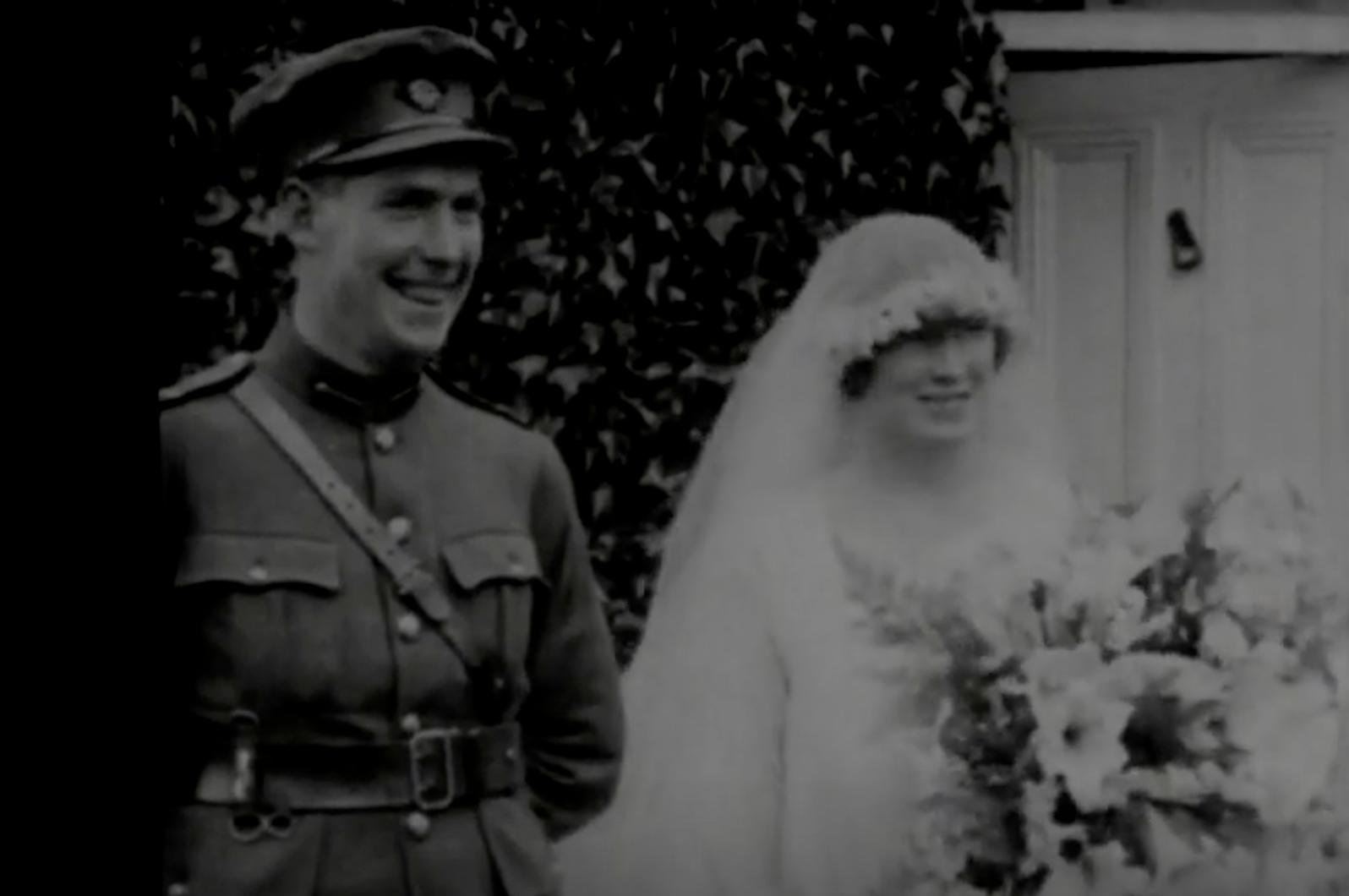Mohill Decade of Centenaries
A relatively random set of bios on people associated with the War of Independence and Civil War in Mohill and south Leitrim.
The definitive source for the history of Leitrim in this era is Leitrim: The Irish Revolution by Mohill's own Patrick McGarty >>>
Sinn Féin in Mohill, 1917
November 1917: Sinn Féin President Éamon de Valera and Harry Boland speak at an Aeríocht organised by the local Edward Daly Sinn Féin Club in Mohill.
By summer 1917, Sinn Féin was gaining popularity. In parliamentary elections, Count Plunkett, father of executed 1916 leader Joseph Mary Plunkett, won in North Roscommon, and Joe McGuinness won in South Longford. Further impetus to Sinn Féin’s growth came in July 1917, with the election of Eamon de Valera and William Cosgrave.
In a mood of contagious enthusiasm, new branches of Sinn Féin appeared all over the country. By July 1917, Leitrim had sixteen clubs with 728 members.
Large public meetings were held around the county, including Mohill. and attracted leaders of Sinn Féin like Michael Collins, Joe McGuinness, William Cosgrave, Darrell Figgis, Éamon de Valera and Harry Boland.
Initially, the crowds were urged to oppose conscription and focus on capturing parliamentary seats.
On the night before an Aeraíocht in Ballinamore in September, hundreds of people gathered at Mohill, Gorvagh and Fenagh. McGuinness assured the crowd that Sinn Féin was not a short-term phenomenon, and urged members to make their clubs into intellectual centres for Irish language and history.
The death of Thomas Ashe at Mountjoy Jail in September 1917, from force-feeding while on hunger strike, was widely condemned across the country. Mohill was one of many places to host a mass and close shops in his memory.
On 17 November 1917, newly-elected Sinn Féin President Eamon de Valera and Harry Boland arrived in Mohill to speak at an Aeríocht on the 18th organised by Mohill’s Edward Daly Sinn Féin Club. On arrival, the visitors were escorted by thirty horsemen and a torchlight procession to a reception in the local Canon Donohue Hall. De Valera was welcomed by the local Board of Guardians. In his speech de Valera condemned Sinn Féin’s political opponents who he claimed, were trying to brand the movement – ‘as pure and good a National movement as there ever was in any country’ – as immoral’.
____
Source: Patrick McGarty, Leitrim The Irish Revolution 1912-23 (2020)
The 1918 Election
The 1818 election
From the 1870s, Ireland's electoral landscape was dominated by the Irish Parliamentary Party, led by Isaac Butt, John Redmond and Charles Stewart Parnell. In summer 1914, Redmond succeeded in securing passage of the Irish Home Rule Bill, but the outbreak of World War I deferred its implementation, and divided Irish nationalists.
When Ireland went to the polls on 14 December 1918, WWI was just over, and the events of 1916, led by the Irish Volunteers, had galvanised a new generation of nationalists.
The Sinn Féin party, founded by Arthur Griffith in 1904/05, had not been involved in the Easter Rising, but became the vanguard of the new national movement. They triumphed in 1918, winning 73 of the 105 Irish seats and 48% of the vote.
On 14 December 1918, Leitrim elected Sinn Féin’s James Nicholas Dolan of Manorhamilton with the help of local volunteer men and women who canvassed, catered and collected voters.The local Volunteers and members of Cumann na mBan took an active part in the election.
Leitrim’s new TD, James Nicholas Dolan had been involved with Sinn Féin since 1908 when his eldest brother, Charles became first Sinn Féin candidate to contest a parliamentary seat. James was interned after 1916 and imprisoned at the time of the 1918 election. He polled 17,711 votes to his nationalist opponent's 3,096: the largest majority in the country for a contested seat.
__________
From the witness statements of:
Patrick Joseph Hargaden, Adoon, Gorvagh, Vice-Comd’t. 3rd Battalion South Leitrim Brigade IRA. Bureau of Military History, WS1268; and Mrs. Bridget Doherty, Cloone, President South Leitrim Cumann na mBan, Bureau of Military History, WS1193.
www.militaryarchives.ie
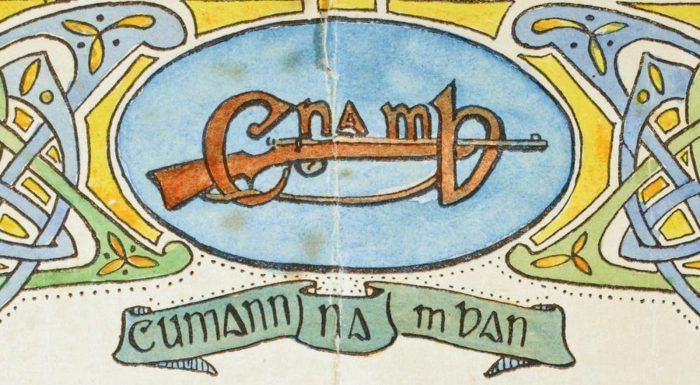
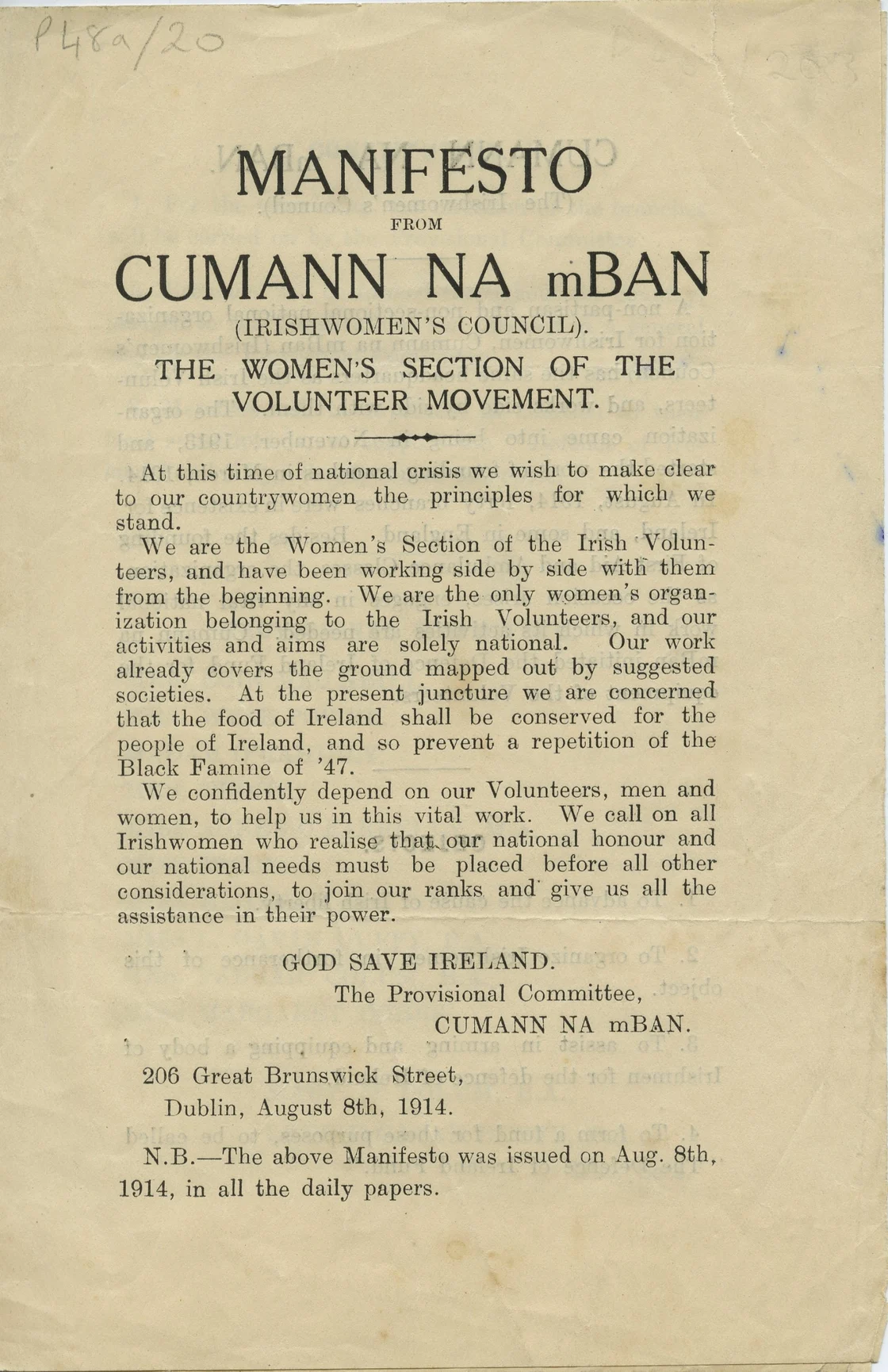
Cumann na mBan and the 1918 election
Bridget Doherty, Cloone, President South Leitrim Cumann na mBan
Bridget Doherty recalled the work of the Cumann na mBan volunteers in Mohill during the 1918 elections:
‘There was plenty of work for everyone in canvassing, collecting election funds and organising transport to take the people to the polling stations. The Volunteers also did duty at the meetings prior to polling day. On polling day we were on duty in Mohill town while others of our company went to Carrick-on-Shannon. Personation was indulged in on a large scale and our men voted for absentee or dead voters. There was no trouble and the election went off quietly enough. After the polling was closed, some of our men did guard on the voting boxes and accompanied them to Carrick-on-Shannon where counting took place. They were away for almost a week on this duty.’
Extensive personation
‘The Cumann na mBan members made and distributed a large amount of flags and emblems. On polling day we took over at vacant house in the village and in this we catered for the Volunteers who were on duty that day. That day we also personated extensively. We dressed in different clothes and voted in the name of absentee voters. We bought the food stuffs required for this day out of our little accumulated fund. This consisted mainly of cooked ham and bread and tea. We packed food parcels for the Volunteers who were going out of the area on duty such as the Volunteers who were escorting the ballot boxes.’
__________
From the witness statements of Mrs. Bridget Doherty, Cloone, President South Leitrim Cumann na mBan, Bureau of Military History, WS1193. www.militaryarchives.ie
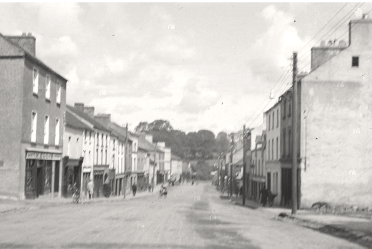
War of Independence: Boycott in Mohill, 1920
In June 1920, the Royal Irish Constabulary (RIC) was boycotted across the country. The boycott extended to officers, their families, and anyone who interacted or worked for them.
[The boycott was] an effort to compel them to resign from the Force and to bring home to them that while acting as such they were the enemies of the people and were not wanted by them.
Shopkeepers who supplied the R.I.C. with groceries and other goods were visited by the Volunteers and ordered not to supply them any longer. On the whole, the shopkeepers loyally carried out this order and the police were compelled to commandeer their requirements which, to give credit to them, they duly paid for at this stage.
Later on, when things became more serious and with the advent of the Tans and Auxies it was unusual for them to pay for anything they took. It was laughable to see policemen entering public houses and pulling pints of beer for themselves.
One individual trader in Mohill continued to supply milk to the R.I.C. despite several warnings from us, so we took his cows and drove them to Aughavas where we kept them for a long time. We eventually gave the cows back whew the owner satisfied us that he would not voluntarily supply the police with milk. The cows were well cared for during their sojourn and milked regularly.
A boycott of Belfast goods was now instituted by orders of headquarters. From Belfast came the vast majority of the goods that were sold in the stores in these parts. Lists of Belfast firms who were on the black list were supplied to us and we raided the trains and vans for the goods of those firms. When we found such goods which was nearly always we destroyed them or commandeered them.
Bread vans were turned upside down and their contents spilled on the roadside and, in a short while, we had driven Belfast goods from the area. Shopkeepers were warned not to deal in goods that were blacklisted under penalty if they did so which might mean the destruction of their shops.
One woman in Mohill, who was really a supporter of Sinn Féin, continued to deal in Belfast bread despite being warned she was not to do so. We waylaid the van delivering the bread to her and, having released the horse from it, let it run down a ravine where it overturned and smashed. That finished that episode as the firm did not attempt to supply any further bread.
______
From the witness statement of Patrick Joseph Hargaden, Adoon, Gorvagh, Vice-Comd’t. 3rd Battalion South Leitrim Brigade IRA. Bureau of Military History, WS1268. www.militaryarchives.ie
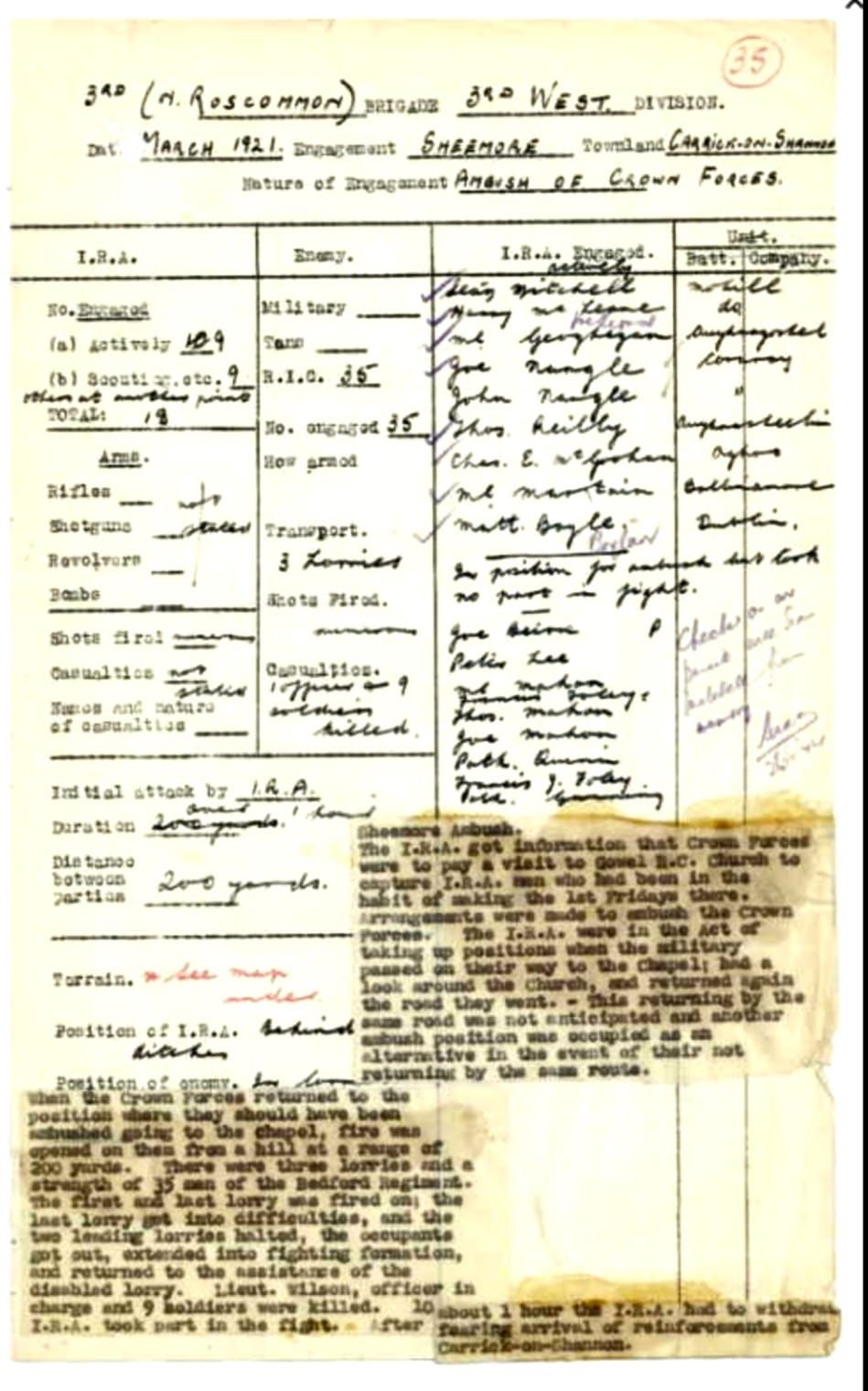
War of Independence: Fanny (Frances) Nangle and Bridget Doherty
In 1921, Charles Pinkman was an Intelligence Officer for the IRA, South Leitrim Brigade. In his witness statement in the Military Archives, he states:
‘I had a few private agents as well: Miss Nangle in the post office in Mohill’ . . They kept us informed of phone messages to the enemy posts and supplied me with copies of code messages.'
This was a hugely risky endeavour for Fanny Nangle. Bridget Doherty's witness statement demonstrates the dangers faced by female agents, including being strip-searched (see image below).
‘'A few days after Kate Healy's arrest they raided my house . . . where I was undressed almost naked.' 'I am positive that one of the searchers was a man dressed up as a woman'. [ ] They stole a watch belonging to my brother and also some money.' I was just after delivering two despatches to a man in the bog for Seán Mitchell, the Brigade O/C who was with the column. Had they arrived some time earlier they would have got them on me.'
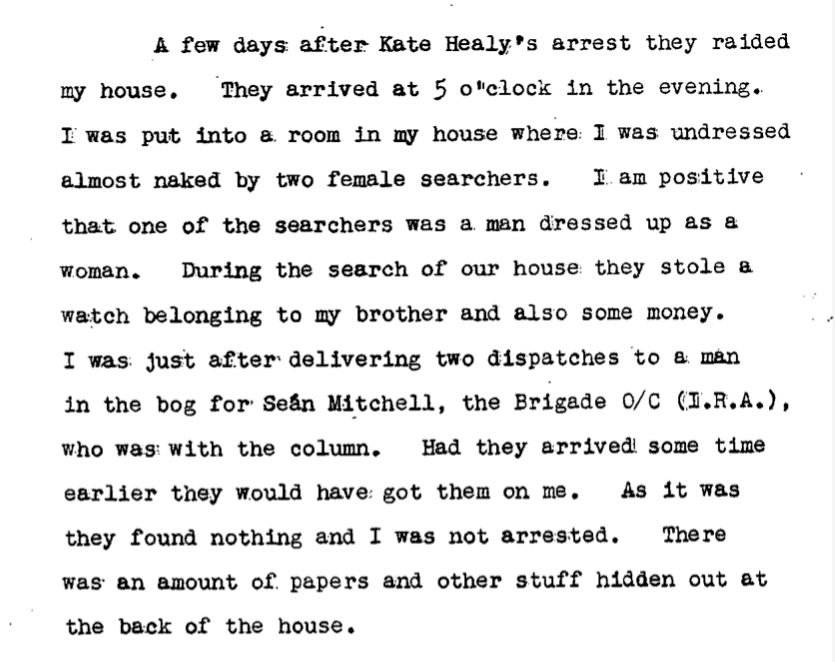
__________
WS Ref #: 1263 , Witness: Charles Pinkman, Intelligence Officer, IRA, South Leitrim Brigade, 1921 BMH.WS1263.pdf, 7; witness statements of Mrs. Bridget Doherty, Cloone, President South Leitrim Cumann na mBan, Bureau of Military History, WS1193. www.militaryarchives.ie.
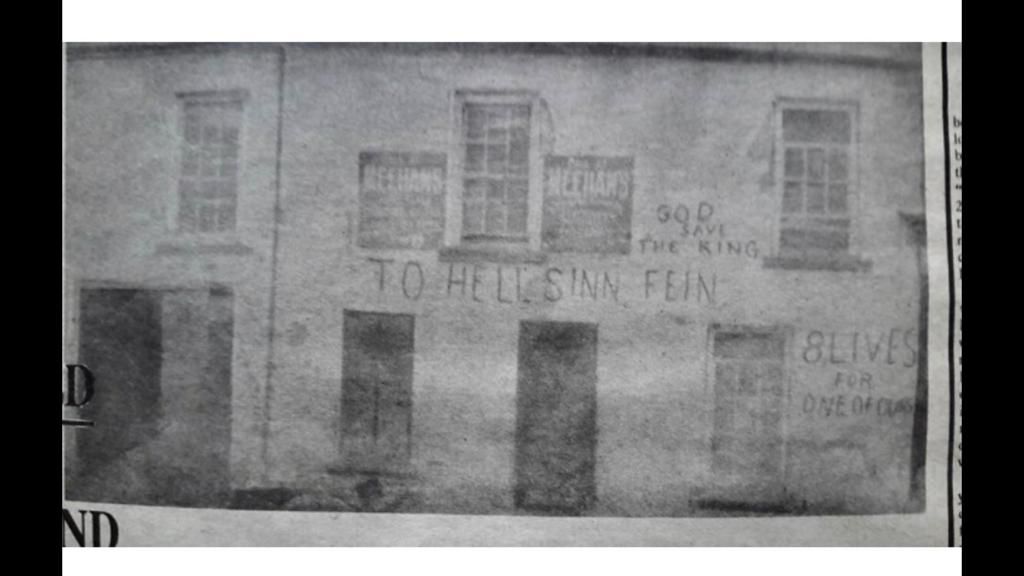
The Black & Tans, 1920
The Black and Tans ‘established a very strong post in Mohill, taking over three or four houses and converting them into a barracks and fortifying them with sandbags, barbed wire and steel shutters on the windows’.
‘With the advent of the Tans and Auxies things took a different shape. Raids, arrests and beatings and general searches and rough handling of individuals now became the order of the day. A general reign of terror tactics was started by the new forces and houses were burned by them. It was remarkable how a force new to the country could have such knowledge as they had of who was who and it was quite evident that again the R.I.C. were supplying the information on which they worked. In fact, many of the R.I.C. now became just as aggressive as the Tans or Auxies did.’
‘Every day the enemy were raiding and looking for individuals who were prominent in the movement heretofore, and soon most of these men were on the run, trying to keep alive. Men who were arrested and taken to the various police barracks could see lists of wanted men posted up on the walls inside the barracks. In most cases the ranks credited to these men in the I.R.A. were all wrong. Shortly after the arrival of the Black and Tans they burned the local Halls at Drumsna, John's Bridge (Barnaculla) and Garvagh. There was no reason why they should have done this, except just to terrorise the people.’
‘In June 1920, a consignment of steel shutters arrived at Mohill station for the police and were put in the Goods Store pending collection. Joe Mitchel, in charge of a party of Volunteers, went to get those shutters and remove them. When they got to the Goods Store they were fired on by a concealed guard of police and were lucky to escape with their lives. No guard had been on the place previous to this and they were very nearly caught in a neat trap.'
Truce
‘We were all glad when the Truce took place [in 1921]; glad to be able to go home and to knock around again and meet in a normal manner. Yet it was a mystery to us and we took a long time to get used to it. You were inclined either to go for a gun or to run when the Tans came upon you suddenly and it seemed so strange that they were not raiding, holding up people or getting on with their usual antics as before the Truce.’
______
From the witness statement of
Patrick Joseph Hargaden, Adoon, Gorvagh, Vice-Comd’t. 3rd Battalion South Leitrim Brigade IRA. Bureau of Military History, WS1268.
www.militaryarchives.ie
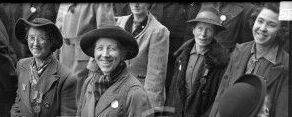
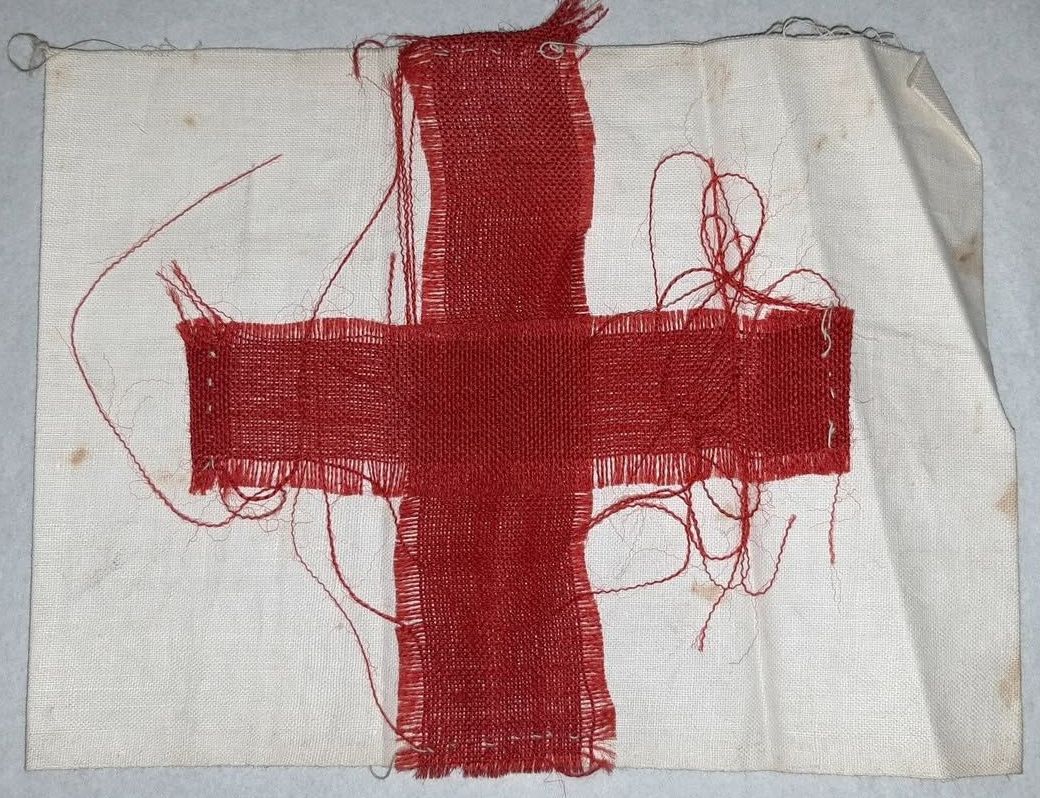
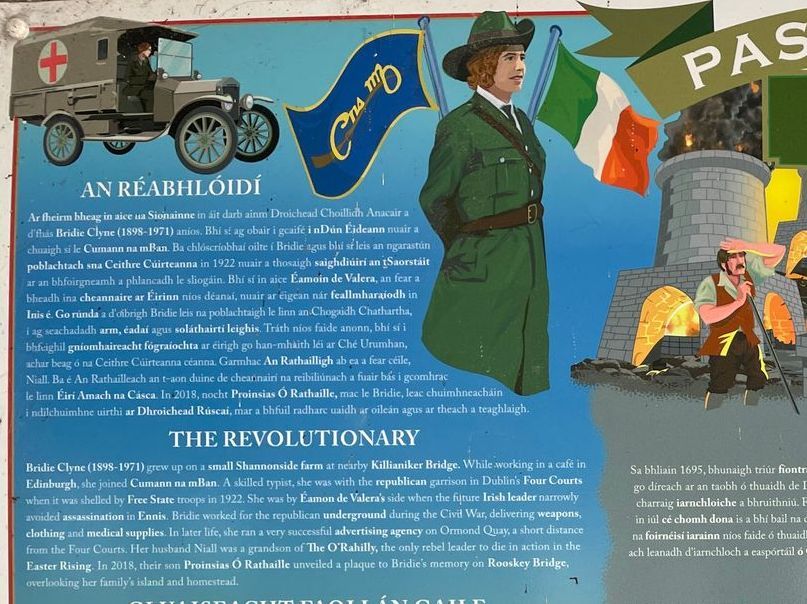
Civil War: Bridie Clyne (1898–1971)
Bridget (Bridie) Clyne, from Dromod More, joined Cumann na mBan in 1919. At 19, she emigrated to Edinburgh but returned and joined Cumann na mBan. She was on the anti-Treaty side in the Civil War and worked for the republican underground in Dublin and Wicklow, delivering weapons, clothing, and medical supplies.. When the Four Courts was shelled in June 1922, she reportedly drove an ambulance through pro-Treaty barricades to bring guns and supplies and aid to anti-Treaty forces. She was said to have been in a car with Éamon de Valera in Ennis when an attempt was made on de Valera's life, and risked her own life driving him to a safe house.
Bridie was arrested in 1923 during a raid on Strand Road in Sandymount; she spent three months in Kilmainham Gaol under the assumed name of Anny Hardwicke, and probably also served time in North Dublin Union jail. Amongst her co-prisoners were Sighle Humphreys and Elgin Barry. Bridie went on hunger strike for a month and during her stay in Kilmainham suffered lifelong injuries to her leg after a warden pushed her down the stairs.
Bridie Clyne married Niall Ó Rathaille, son of The O'Rahilly, in 1940.
In 2018, a plaque commemorating Bridie Clyne was unveiled on Rooskey bridge.
References: https://humphrysfamilytree.com/ORahilly/clyne.html; Leitrim Observer.
The Murder of Dr Muldoon, 1923
On 18 March 1923, in the final months of the Civil War, Dr Paddy Muldoon was shot and killed at Bridge Street, Mohill.
Three men and a priest were implicated in the murder. In the aftermath, it was clear that the IRA, church and major figures in the emerging state all colluded in some way to cover up the killing.
100 years to the day, on Saturday 18 March 2023, Mohill & District Historical & Heritage Society traced Dr Muldoon’s final footsteps with an event that included talks, a public walk, short film, and music.
Read more about the murder and the event here >>>
Watch the film, view the talks and download a booklet of the event.
And share your own story about the murder. >>>
Lieutenant General Seán Mac Eoin
Lieutenant General Seán Mac Eoin, of Ballinalee, County Longford was such a leading figure in the War of Independence that Pathé filmed his wedding to Alice Cooney at St. Mel's Cathedral, Longford in 1922.
Click on the image or here to see the video.
It shows the newly married couple as they emerge from the cathedral after the ceremony. Other visible guests include Sinn Féin leaders Michael Collins and Arthur Griffith.
Read more about him at https://www.seanmaceoin.ie/

